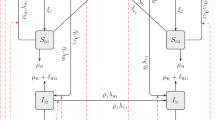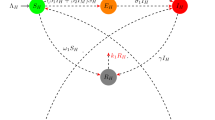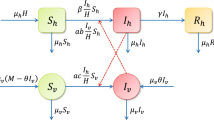Abstract
Zika virus infection is caused by the Zika Virus belonging to the Flaviviridae family. The virus is transmitted to people through the bite of an infected Aedes mosquito. However, although rare, sexual and mother-to-child are also other modes of transmission. The incubation time in infected humans is a few days to a week. The spread of the disease still presents in some developing countries and remote areas that cannot afford basic public health intervention and vaccine, hence, investigating other options are necessary. In this study, we formulate a diffusion mathematical model of the Zika virus with controls (personal protection, medical treatment, and insecticide). In this model, we will be able to observe the spatial movement of individuals and investigate if the disease can be controlled by performing social distancing combined with other control strategies. Further, we investigate the essential dynamics of the model through equilibrium analyses. The basic reproduction number with the spatial movement of the model is derived. Meanwhile, a time-dependent optimal control study is applied to the model to seek a cost-effective strategy to eradicate Zika virus outbreaks. Numerical results show that strategically deployed personal protection, treatment, and insecticide can significantly reduce the number of infectious individuals and mosquitoes. Also, applying a social connection program can additionally reduce the spread from one place to another, and thus the number of infections in total is reduced.












Similar content being viewed by others
References
Daozhou G, Yijun L, Daihai H, Travis CP, Yang K, Gerardo C, Shigui R (2016) Prevention and control of Zika as a mosquito-borne and sexually transmitted disease: a mathematical modeling analysis. Nat: Sci Rep 6(28070):1–10
Zika virus, http://www.who.int/mediacentre/factsheets/zika/en/
Zika virus, https://www.cdc.gov/zika/hc-providers/clinical-guidance/sexualtransmission.html
Onuorah MO, Ademu A, Obi EI, Hasheem AM (2016) Deterministic mathematical model of Zika virus. Res J Math 3(3):1–15
Role of short-term dispersal on the dynamics of Zika virus, https://arxiv.org/pdf/1603.00442.pdf
Chunxiao D, Nana T, Yuanguo Z (2016) A mathematical model of Zika virus and its optimal control. In: Proceeding of the 35th Chinese control conference
Goswami N, Srivastav A, Ghosh M, Shanmukha B (2018) Mathematical modeling of zika virus disease with nonlinear incidence and optimal control. J Phys: Conf Ser
Suparit P, Wiratsudakul A, Modchang C (2018) A mathematical model of Zika virus transmission dynamics with a time-dependent mosquito biting rate. Theor Biol Med Model 15:1–11
He D, Zhao S, Lin Q, Musa S, Stone L (2020) New estimates of the Zika virus epidemic attack rate in Northeastern Brazil from 2015 to 2016: a modelling analysis based on Guillain-Barré Syndrome (GBS) surveillance data. PLoS Negl Trop Dis 14(4):e0007502
Zhao S, Stone L, Gao D, He D (2018) Modelling the large-scale yellow fever outbreak in Luanda, Angola, and the impact of vaccination. PLoS Negl Trop Dis 12(1):e0006158
He D, Gao D, Lou Y, Zhao S, Ruan S (2017) A comparison study of Zika virus outbreaks in French Polynesia, Colombia and the State of Bahia in Brazil. Sci Rep, 7: Article number 273
Banuelos S, Martinez MV, Mitchell C, Prieto-Langarica A (2019) Using mathematical modelling to investigate the effect of the sexual behaviour of asymptomatic individuals and vector control measures on Zika. Lett Biomath 6(1):1624631–1624644
Van DDP, James W (2002) Reproduction numbers and sub-threshold endemic equilibria for compartmental models of disease transmission. Math Biosci 180:29–48
Carlos CC, Zhilan F, Wenzhan H (2002) On the computation of \(R_0\) and its role on the global stability. In: Mathematical approaches for emerging and reemerging infectious diseases: an introduction. Institute for Mathematics and Its Applications, 125, pp 229–253
Turing A (1952) The chemical basis of morphogenesis. Philos Trans R Soc B 237:37–72
Hsu SB, Wang FB, Zhao XQ (2013) Global dynamics of zooplankton and harmful algae in flowing habitats. J Differ Equ 255:265–297
Thieme HR (2009) Spectral bound and reproduction number for infinite-dimensional population structure and time heterogeneity. SIAM J Appl Math 70:188–211
Wang W, Zang X-Q (2012) Basic reproduction numbers for reaction-diffusion epidemic models. SIAM J Appl Dyn Syst 11:1652–1673
Jin W, Chairat M (2011) Modeling cholera dynamics with controls. Can Appl Math Q 19:255–273
Author information
Authors and Affiliations
Corresponding author
Rights and permissions
About this article
Cite this article
Wattanasirikosone, R., Modnak, C. A diffusion model of Zika virus with human-vector transmission dynamics and control strategy including social distancing study. Int. J. Dynam. Control 9, 350–362 (2021). https://doi.org/10.1007/s40435-020-00653-8
Received:
Revised:
Accepted:
Published:
Issue Date:
DOI: https://doi.org/10.1007/s40435-020-00653-8




